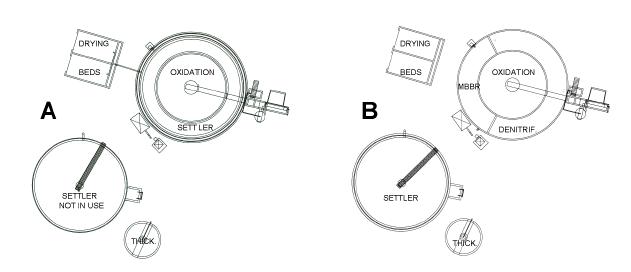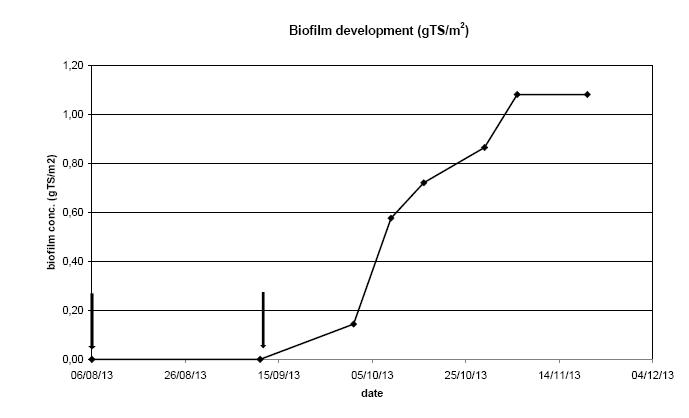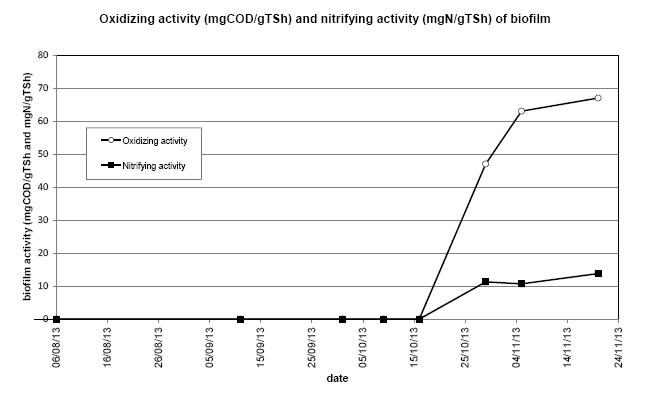1. Introduction
In moving bed biofilm reactors (MBBR) the biomass grows as a biofilm on small plastic carriers that move freely into the wastewater; mixing biofilm reactors the biomass grows only on carriers, while in hybrid reactors there are both biofilm and suspended activated sludge in the same tank. Several processes with different kinds of floating carriers have been developed [1], with porous materials such as polyurethane and with nonporous material such as polyethylene. The process with the largest number of applications is the AnoxKaldnesTM MBBR with more than 400 plants in the world; it was developed in Norway, initially as a pure biofilm process, in a cooperation between the research institute SINTEF of Trondheim and the company AnoxKaldnesTM [2, 3], and patented in 1991-1994. This technology is versatile and is applied for organic substance removal, nitrification and denitrification with several plant configurations; with sequencing-batch MBBR, biological phosphorus removal can be achieved [4]. Reactors for organic substance removal are usually dimensioned with surface loads as 6 kgBOD/m2d when 90% removal is requested; but for first-stage treatment of concentrated industrial wastewater, surface loads reach 30-100 kgCOD/m2d [5]. Organic substance has a negative effect on nitrification, which is almost inhibited when surface load is higher than 5 gBOD/m2d [6]. Nitrification rate depends strongly on oxygen concentration (which is the limiting substrate when the ratio O2/N < 2); effect of temperature decrease is negative on nitrification rate but positive effect on oxygen solubility in water [7, 8]. Literature reports values of 0.8-1.0 gN/m2d at 15 ℃ and 5 mg/L O2 with a secondary effluent [9], 0.5-0.7 gN/m2d at 7-15 ℃ and 3.5-13.3 mg/L O2 in a plant with 8 serial MBBR, 5 of which were aerated [10], 0.5 gN/m2d at 6.4 ℃ and 6.5 mg/L O2 in a plant with 9 serial MBBR, 4 of which were aerated [11]. With a pure oxygen tertiary MBBR, nitrification rates of 1.2-4.3 gN/m2d were achieved at 16-20 ℃ and oxygen concentrations until 20 mg/L [12]. Denitrification can be achieved with pre- or post-denitrification scheme; literature reports surface pre-denitrification rates of 0.4-0.7 gN/m2d at 15 ℃ with raw wastewater (ratio COD/N > 3), specific post-denitrification rates of 1.2 gN/m2d at 15 ℃ with sodium acetate as carbon source [7, 10]. Some case studies of hybrid plants with AnoxKaldnesTM carriers are also reported in literature, mainly as pilot scale researches [13, 14, 15] and upgrading of existing activated sludge plants on basis of results of previous pilot scale experiments: Klippan in Sweden [16], Broomfield in U. S. A. [17, 18], Maserà in Italy [19], Gavà-Viladecans in Spain [20]. Studies report that nitrification is significantly improved with hybrid MBBR, according to Christensson and Welander [16] ca. 85% of nitrification is due to biofilm; organic substance oxidation and sludge setteability is also improved.
This paper deals with the wastewater treatment plant of Porto Tolle (Italy), which was upgraded by dividing an existing tank into an activated sludge denitrification tank, an activated sludge oxidation tank and a hybrid MBBR oxidation tank.
2. Plant description
The wastewater treatment plant of Porto Tolle (RO, Italy) was originally projected for 2200 p. e. ; expected loads were 550 m3/d, 264 kgCOD/d, 132 kgBOD/d and 26 kgN/d. Emission limits were stated by the Regional Plan for Water Resanation and were: TSS ≤ 35 mg/L, COD ≤ 125 mg/L, BOD ≤ 25 mg/L, NH4+ ≤ 20 mg/L, NO2-N ≤ 1 mg/L, NO3-N ≤ 30 mg/L, P ≤ 10 mg/L. The plant was originally made of a pumping station, a circular activated sludge oxidation tank (395 m3) aerated by a 1480 Nm3/h blower and fine bubble diffusers, a sedimentation unit in the external circular crown (315 m3), and two drying beds for sludge (Figure 1A). Other units were built but not yet in use in 2008: a fine screen, a sand and grit removal unit, a circular sedimentation tank (570 m3), a disinfection tank with peracetic acid and a sludge thickener. According to average data of 2007, the plant treated 1898 m3/d with 35 mg/L TSS, 75 mg/L COD, 37 mg/L BOD, 19.1 mg/L TKN; hydraulic load was 245% higher, organic load was 46% lower and nitrogen load was 39% higher than project values. Wastewater was (and is) very dilute because of infiltrations of rain waters and clean water from the river Po. Even if the plant respected emission limits, the regional environmental law was near to be modified with more strict emission limits for nitrogen and the plant had no denitrification; moreover, higher pollutant incoming loads were expected for following years. So it was decided to modify the plant and to start units that were still not in use; the choice to convert part of existing volume into a hybrid MBBR was justified with the possibility of reducing activated sludge concentration in the plant. So the circular crown was divided into two sections (Figure 1B): a sector of 180 m3 was converted into a predenitrification tank, a sector of 100 m3 was converted into a hybrid MBBR oxidation tank. This reactor was filled with 50% AnoxKaldnesTM K3 carriers (Table 1) and aerated by a new 1000 Nm3/h blower and medium bubbles air diffusers. The plant was modified in July 2013 and restarted with all units in August; carriers were introduced in the MBBR tank in two phases (75% in August and 25% in September).
Table 1. Characteristics of AnoxKaldnesTM K3 carriers
| Shape |
 |
|
Length (mm)
|
12
|
|
Diameter (mm)
|
25
|
|
Density (g/cm3)
|
0.95
|
|
Nr. carriers pr. m3
|
144000
|
|
Maximum filling degree
|
66%
|
|
Effective specific surface (m2/m3 carriers)
|
500
|
3. Material and methods
The upgraded plant was studied in the period 12 August-22 November 2013; hydraulic load was measured daily and samples were taken every week form raw wastewater and final effluent. These samples were analyzed to determine concentration of TSS, COD, BOD, TKN, NH4-N, NO2-N, NO3-N and total nitrogen (Tot-N); analysis were conducted according to Italian standard methods published by IRSA-CNR. Since 15 September, samples of carriers were taken from the hybrid MBBR every two weeks to determine biofilm concentration, oxidizing activity and nitrifying activity with laboratory batch tests. Biofilm concentration was determined as difference of dry weight between 100 carriers with biofilm and the same carriers after cleaning with sodium hypochlorite solution. Oxidizing activity of biofilm was determined as follows: 100 carriers with biofilm were put in contact with 1 L raw wastewater under constant aeration; at the beginning of the test and after 1 hour samples were taken, filtered and analyzed to determine COD concentration; the difference between these values was divided by biofilm concentration to calculate oxidizing activity (mgCOD/gTSh). Nitrifying activity was determined in a similar way, but a standard solution of ammonium chloride (ca. 50 mg/L) and sodium hydrogen carbonate (ca. 200 mg/L) was used instead of raw wastewater, and nitrifying activity (mgN/gTSh) was calculated from the difference in ammonium concentration divided by biofilm concentration.
4. Results and discussion
Results of analysis during restarting phase of the upgraded plant are listed in Table 2; influent pollutant concentrations were very low, mainly because of significant infiltrations of rain waters and clean water from the river Po; this dilution explains reasonably pollutant removal efficiencies which were not as high as expected. The plant respected always emission limits. Average pollutant loads were 90.5 kgCOD/d, 36.5 kgBOD/d and 21.1 kgN/d; since the plant was upgraded to treat up to 180 kgCOD/d, 90 kgBOD/d and 60 kgN/d, it has still significant residual capacity.
Table 2. Hydraulic load and pollutant concentrations at the plant of Porto Tolle
| Note: when values were lower than detection limits, for calculations of average values and removal efficiencies they were considered as half of detection limits. |
| Parameter | | Raw influent | Final effluent | Removal |
| min | average | max | min | average | max |
| Hydraulic load | m3/d | 306 | 1587 | 2208 | 306 | 1587 | 2208 | |
| TSS | mg/L | < 10 | 15 | 28 | < 10 | 11 | 32 | 63% |
| COD | mg/L | < 25 | 57 | 214 | < 25 | 25 | 49 | 56% |
| BOD | mg/L | < 5 | 23 | 111 | < 5 | 6 | 15 | 74% |
| TKN | mg/L | 6.0 | 13.3 | 41.3 | < 4 | < 4 | < 4 | 85% |
| NH4-N | mg/L | | | | < 0.5 | < 0.5 | < 0.5 | |
| NO2-N | mg/L | | | | < 0.1 | < 0.1 | < 0.1 | |
| NO3-N | mg/L | | | | 7.3 | 10.7 | 12.4 | |
| Tot-N | mg/L | 6.0 | 13.3 | 41.3 | 7.3 | 10.7 | 12.4 | 20% |
Figure 2 shows biofilm growth in the hybrid MBBR tank, the two arrows indicate carriers introduction. There was no significant biofilm growth for almost two months after first carriers introduction (75% of total carriers amount); then biofilm concentration reached 1.1 gTS/m2 (0.27 kgTS/m3 tank) in one month; in the same period activated sludge concentration was 2.0-2.8 gTSS/m3. The start-up period of this plant was longer than the ones encountered by other two authors for similar hybrid MBBR plants fed with municipal wastewater; Di Trapani et al. [13] report that their pilot plant reached good working conditions one month after starting-up; Christennson and Welander [16] report a start-up period of 49 days for their pilot plant; Santamaria et al. [20] report a start-up period of one month. The slower biofilm growth in the hybrid MBBR of Porto Tolle can be explained with the significant dilution of raw wastewater; the plant studied by Di Trapani et al. treated an influent with 257-632 mg/L COD and 23-54 mg/L NH4. N, and the plant studied by Christennson and Welander treated an influent with 186-256 mg/L COD and 31-37 mg/L NH4-N. The plant studied by Santamaria et al. treated an influent with 289-481 mg/L BOD. The first biofilm growth in the full-scale hybrid MBBR plant of Maserà [19] required one month; that plant treated an influent with 210-680 mg/L COD and 40-96 mg/L TKN, and biofilm concentration reached 1.7 gTS/m2 in less than 3 months after carriers introduction.
Figure 3 shows oxidizing activity and nitrifying activity of biofilm; significant activity (67 mgCOD/gTSh and 13.8 mgN/gTSh) was evidenced since the end of October. Since biofilm concentration was ca. 1.1 gTS/m2 in that period, these values can be converted into superficial removal rates, i. e. respectively 1.77 gCOD/m2d and 0.36 gN/m2d. Christennson and Welander [16] report higher superficial nitrification rates (0.86-1.18 gN/m2d); also this significant difference can be explained considering the dilution of influent wastewater of Porto Tolle.
5. Conclusion
These results confirm that hybrid MBBR is a suitable technology to upgrade existing activated sludge wastewater treatment plants in limited space without building new tanks. The plant of Porto Tolle was overloaded hydraulically and for nitrogen, and had no denitrification in its original scheme. So the old settler was converted into a predenitrification tank and a hybrid MBBR tank, and another settler (already built but not yet in use in 2008) was connected to the biological section. The plant was so upgraded to treat up to 180 kgCOD/d, 90 kgBOD/d and 60 kgN/d; the same biological section without carriers could treat up to 120 kgCOD/d, 60 kgBOD and 40 kgN/d with current emission limits.
During the start-up phase the plant received very diluted wastewater with 57 mg/L COD, 23 mg/L BOD and 13.3 mg/L TKN on average basis. Thus pollutant removal efficiencies were apparently low even if the plant respected emission limits. First biofilm growth was observed ca. two months after first carriers introduction, and its concentration reached 1.1 gTS/m2 in the following month. Start-up time was longer and biofilm concentration was lower than respective values reported by other authors for similar hybrid MBBR plants, reasonably because of very low BOD and TKN concentration in incoming wastewater. Laboratory batch tests on biofilm evidenced an oxidizing activity of 67 mgCOD/gTSh (1.77 gCOD/m2d) and a nitrifying activity of 13.8 mgN/gTSh (0.36 gN/m2d).
The plant has a significant residual capacity (both for organic substance oxidation and for total nitrogen removal) that will be useful for future pollutant load increases or if emission limits become stricter than current ones.
Conflict of Interest
All authors declare no conflicts of interest in this paper.










 DownLoad:
DownLoad: 








